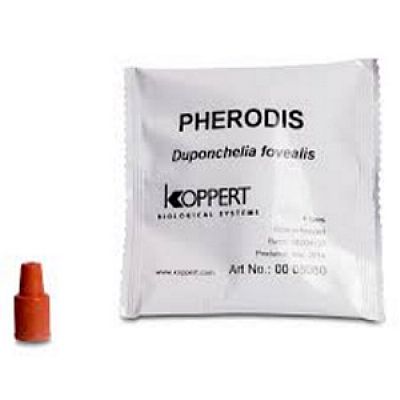PHERODIS
Target
Detection of butterflies/moths, beetles or male, alate mealy bugs.
Dosage
- For every species of butterfly/moth that may appear, use two or four dispensers per hectare.
- For mealy bugs, use one dispenser per 500 - 1000 m2.
The information given below is merely indicative. Tailored advice can be provided if information is available on the local factors that need to be taken into account, such as the crop, the climate conditions and the level of infestation. For the correct approach, please consult a specialist of our group.
Packaging
Packs of 4 pheromone dispensers with a species-specific sex pheromone.
How does Pherodis work
The Pherodis’ capsules release of a species-specific sex pheromone to lure adult males of the species of pest concerned into the trap. There they become stuck to the adhesive plate, making them easy to detect, count and identify.
Available pheromones
|
Adoxophyes orana
|
Eupoecilia ambiguella
|
Plodia / Ephestia
|
|
Agrotis segetum
|
Euzophera punicaella
|
Plutella xylostella
|
|
Agrotis ipsilon
|
Grapholita lobarzewskii
|
Prays oleae
|
|
Anarsia lineatella
|
Grapholita molesta
|
Rhagoletis cerasi
|
|
Autographa gamma
|
Helicoverpa armigera
|
Riptortus clavatus
|
|
Cacoecimorpha pronubana
|
Heliothis virescens
|
Sesamia nonagrioides
|
|
Cameraria ohridella
|
Keiferia lycopersicella
|
Spodoptera exigua
|
|
Ceratitis capitata
|
Lacanobia oleracea
|
Spodoptera littoralis
|
|
Chilo suppressalis
|
Lobesia botrana
|
Spodoptera litura
|
|
Chrysodeixis chalcites
|
Mamestra brassicae
|
Symmetrischema tangolias
|
|
Clepsis spectrana
|
Musca domestica
|
Synanthedon myopaeformis
|
|
Cossus cossus
|
Operophtera brumata
|
Synanthedon pyopaefo
|
|
Cryptophlebia leucotreta (Thaumatotibia leucotreta)
|
Opogona sacchari
|
Synanthedon tipuliformis
|
|
Cydia funebrana
|
Ostrinia furnacalis
|
Tecia solanivora
|
|
Cydia pomonella
|
Ostrinia nubinalis(EZ-strain)
|
Thaumetopoea processionea
|
|
Cydia pyrivora
|
Pandemis heperana
|
Thaumatotibia leucotreta (Cryptophlebia leucotreta)
|
|
Cydia splendana
|
Pectinophora gossypiella
|
Trichoplusia ni
|
|
Cylas formicarius elegantul
|
Phtorimaea operculella
|
Tuta absoluta
|
|
Dacus oleae
|
Phyllonocyter corylifoliella
|
Vitacea polistiformis
|
|
Duponchelia fovealis
|
Phyllonorcyter blancardella
|
Zeuzera pyrina
|
Application
-
Collect the sachets containing the pheromone dispensers from the cold store and open the sachets. Do not touch the dispenser, since manual contact can spread pheromones to other areas in the glasshouse.
-
Place the capsule on the adhesive plate of the Deltatrap and hang the trap in a suitable position.
-
Hang the traps approx. 10 centimeters above the crop in a location where they can readily be inspected (e.g. along the centre aisle).
-
Distribute the traps as evenly as possible over the area, in order to avoid interference.
-
Assign each Deltatrap a serial number. Write down the trap’s serial number and the type of pheromone it contains on the outside.
-
Wash your hands between assembling pheromone traps for different species of butterflies and moths.
-
During the first few days following the installation of a new pheromone capsule, moths or butterflies may be caught more often than usual. That is because of the greater release (temporarily) of the pheromone from the new capsule.
-
Pheromone dispensers remain effective for 6 weeks. Replace the capsule in the trap after 6 weeks, but only with a dispenser containing the same kind of pheromone.
-
Never open the “plastic tube” type of pheromone dispenser because the pheromone will evaporate almost immediately and completely. The plastic tube is permeable, and the pheromone will gradually diffuse through the wall.
Storage
-
Pheromone dispensers (and the sachets containing them should preferably be kept in a freezer (-18°C), and in any case at temperatures below 4°C.
-
The production date is printed on the packaging. The dispensers have a shelf life of 2 years after the production date when stored in a freezer, and 1 year when stored in a refrigerator (4-6°C).



 HellasSITES
HellasSITES